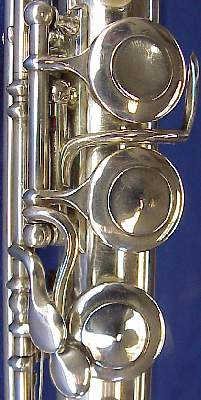

 |
Theodore Berteling
|
 |

 In his 1868 patent Berteling moved all clutches for the coupling of the keys to the back side of the flute (see images of later wood Berteling flute). This flute has ball adjusters much like the standard Boehm arrangement, leading me to surmise that it may predate Berteling's patent.  |
 |
LEFT: The upper R1
trill touch
is B-C rather than Bb. The lower touch duplicates L3 for G-A or
G#-A
trills. G# is (thankfully) closed. Trill key spring arrangement is unique. The attachment point is an extension of the upper post of the left hand mechanism and also acts to stabilize the trill rod.  The wood crown is female threaded to mate with the wooden screw cork adjuster and perforated for the silver pin cork position indicator. Crown was originally silver clad and engraved. |
 Berteling's
workmanship on this flute is fine throughout. The mechanism has
held
up remarkably well over the decades, and the only evidence of repair
would
be the 5mm by 60mm silver strip applied longitudinally along the
headjoint
to reinforce the seam between the embouchure and the tenon.
Berteling's
workmanship on this flute is fine throughout. The mechanism has
held
up remarkably well over the decades, and the only evidence of repair
would
be the 5mm by 60mm silver strip applied longitudinally along the
headjoint
to reinforce the seam between the embouchure and the tenon.
The instrument plays well and produces a delicate but very clear sound. The scale is quite usable, but an overhaul with thinner pads would allow for proper venting and probably improve intonation.
A special thanks to Peter Spohr's article on
early
American Boehm flutes in the Journal of the American Musical
Instrument
Society (Volume XXV) for a most detailed description and commentary
on a similar and probably later flute of Theodore Berteling.
Images © J.
W. Sallenger